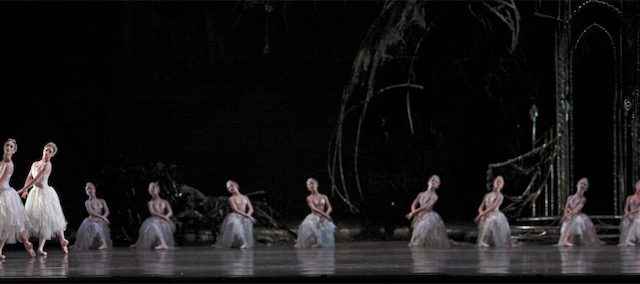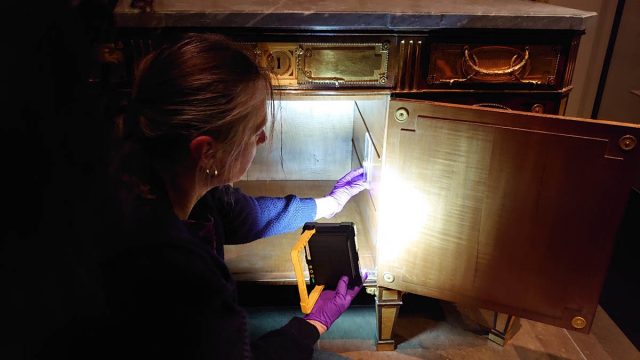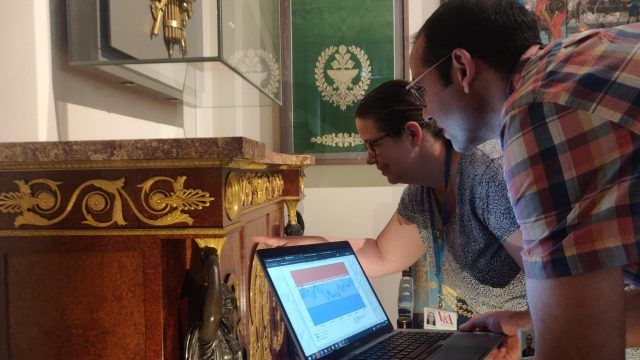by Jane Rutherston, Head Book Conservator
In 1875, Julia Margaret Cameron published two volumes ‘each with twelve plates plus portraits of Tennyson as frontispiece and excerpts from his poems lithographed from her handwriting’1. The request to include the V&A’s two volumes of ‘Idylls of the King’ for the ‘Julia Margaret Cameron’ touring exhibition was a golden opportunity to address the urgency of treating these two very important books and secure funding for their conservation. The inherent problems of the materials used and heavy handling had resulted in their degradation, impeding reader usage without causing further damage. On assessment it was apparent that many of the support leaves had become detached due to the deterioration of the cloth guards, resulting in tears along the line of flex (Figure 1). Due to their very poor condition and the request to show more than one photograph from Volume 2, in consultation with Prints, Drawings and Paintings (PDP) curatorial staff, it was agreed that only Volume 1 would be re-bound for the exhibition. The rare decision to allow Volume 2 to remain unbound, facilitating the simultaneous display of six leaves, was on the basis that only two leaves were still attached to the binding and that five support leaves with photographs and one text leaf had previously been mounted for display purposes. This decision also enabled a further two leaves to be included in the touring exhibition ‘Inspiration by Design: Word and Image from the Victoria and Albert Museum’.
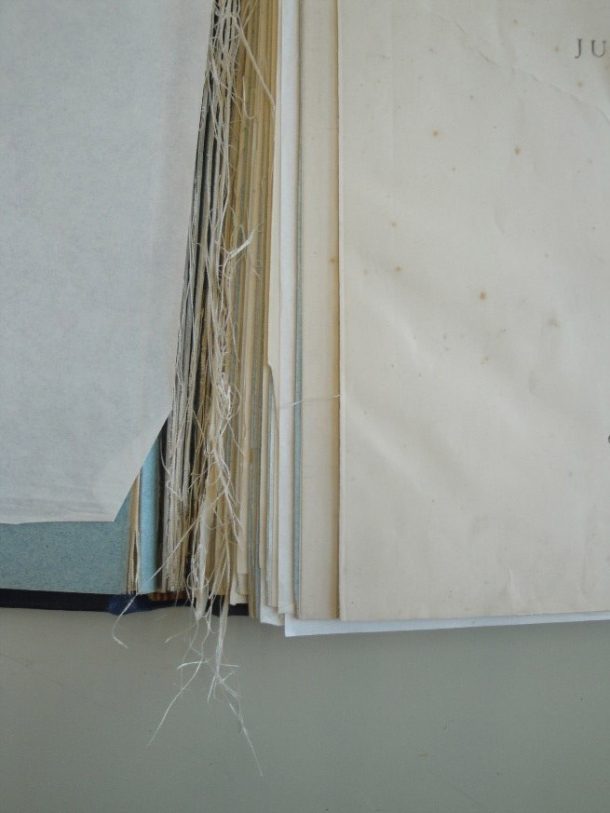
Both volumes had been re-bound in full cloth library-style bindings with cloth jointed endpapers: Vol. 1 into a red cloth and Vol. 2 into a blue cloth binding. Each poem was printed onto a lightweight paper acting as an interleaf which had been tipped to the recto of the support leaf carrying the associated photograph. The text blocks consisted of the support leaves with printed poem made up into bifolia using cream cloth guards and then sewn onto five tapes with machine made end-bands. With so many of the leaves detached, and despite museum numbering of each leaf supporting a photographic image, it was decided to ensure the leaves and associated poems were in the correct order. The Getty Museum, the Harry Ransom Centre (HRC) and George Eastman House were approached by Erika Lederman (Cataloguer, Photographs Section) to provide images of the order in their copies. The research was not conclusive as the copy of Volume 1 belonging to the HRC had the long version of the Lancelot and Elaine verse before the short one, whereas the V&A, Getty and Eastman House volumes had the short verse before the long verse. Having been assured that conservation treatment had not changed the order of the HRC copy, it is unclear whether this inconsistency was deliberate or not. What did become evident was the incorrect recording of our volumes as Vol 1 instead of 2 and 2 instead of 1. V&A records were duly updated in May 2014 to 34-49-1939 Vol.2 (X312) and 81-9-1970 Vol.1.
Volume 1 (81-91-1970)
Comprised 11 support leaves with an image mounted onto mottled blue card with gilt edge and 14 printed leaves. The collation dates in the back of this volume and style of binding suggested that it was possibly rebound in 1954 or 1961. On receipt in the studio all support leaves were detached.
Volume 2 (34-49-1939) remains unbound
Comprised 14 leaves as above, 13 supporting a photographic image and one supporting a typed list of contents. Fifteen printed leaves had been tipped to the front of the associated photograph. The title page, prelims and first poem ‘The May Queen’ had been tipped to each other and then to support leaf 35-1939. On lifting the cloth guard from the first leaf, an earlier cloth guard and remnants of red cloth were revealed. A red cloth guard was exposed under the cloth guard of the first stub. On receipt in the studio, only two support leaves were still attached. On advice from Word & Image Department (WID) curators, and working on visual evidence, the correct sequence of leaves was ascertained and museum extension numbers allocated to the text leaves.
The volumes had extensive damage to support leaves with small areas of loss around edges and at corners and tears to printed leaves, making them vulnerable to further deterioration through handling (Figure 2).
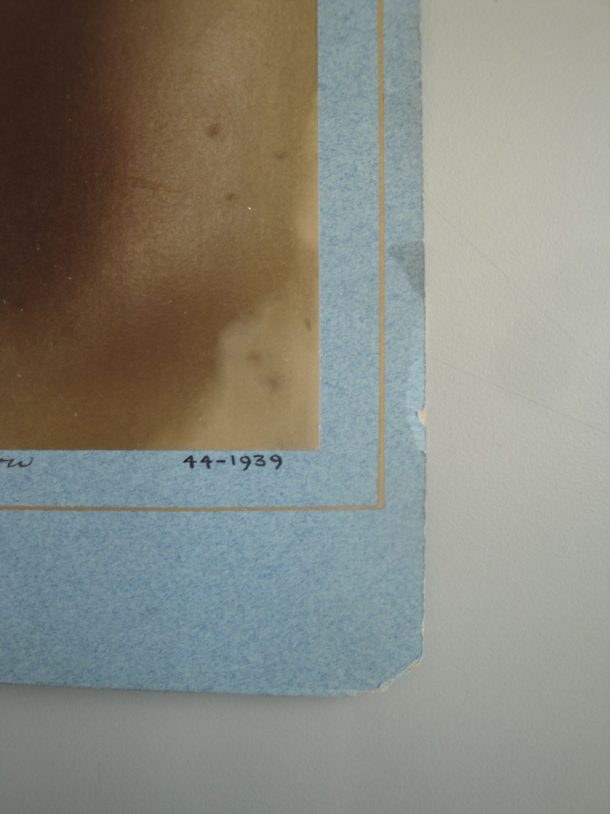
The important consideration for the rebinding was that the structure had to allow for better opening of the text leaves as they were vulnerable along the line of flex where tipped to the support leaf (Figure 3). After lifting the tipped-on edge of each text page a decision was made that these leaves should be given an extension stub to act as a hooked guard to attach it to the relevant support leaf. The support leaves were made up into bifolia, as before, using an airplane cotton lined with Japanese paper and then sewn onto five tapes following the previous sewing pattern and incorporating new endpapers.
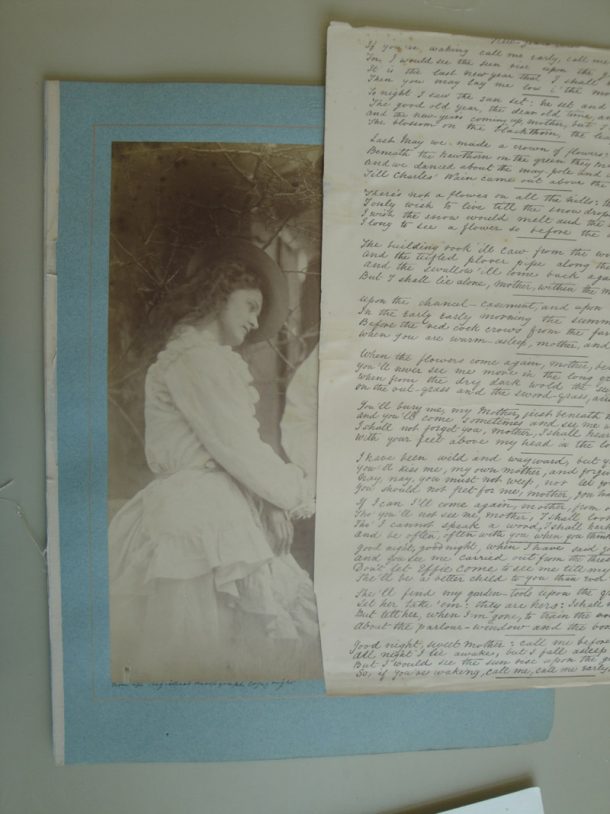
In discussion with Dr Marta Weiss, Curator of Photographs, various options for the binding were discussed. Based on existing covers, examples of which were half bound in black, green or red leather with corresponding coloured cloth sides, it was decided that they should be bound in red leather in keeping with the evidence of the previous red cloth remnants found in Volume 2. Extant bindings show the sides as a pebble embossed cloth with the title blocked in gold onto the front board in varying font sizes and designs and a three line gold fillet across corners and down leather/cloth interface on boards. Although it appears the original endpapers were of similar paper to the support leaves, due to the difficulty in sourcing conservation-sound materials resembling the originals and limited time resources, it was decided to opt for a cream wove paper for the endpaper and to dye an airplane cotton using Novacon (a reactive dye) to an appropriate shade of red as an alternative to the pebble embossed cloth that was likely used on the boards. As there were concerns that the blocking would not fix to the cloth it was also agreed that the title would be blocked onto a large leather label which would then be inset into a recess on the front board. Mock-ups in various fonts and sizes were produced for agreement and then sent off for a block to be made up.
During the project further research by colleagues within the Museum uncovered a file, MA/1/F461, relating to Volume 1 which revealed that it was received by the Museum on 9th May 1927 as a gift from a Miss Agnes May Ffytche. ‘Ffytche grew up at Freshwater, Isle of Wight, where Cameron had her home. Her father, Lewis Ffytche, was a first cousin of Alfred Tennyson’2 and according to Ffytche, the album was ‘put together specially for [her] mother’. The records show that this volume only had 11 photographs rather than the 13 found in other volumes, which indicates it came into the collection incomplete, which would tally with the 11 stubs bound into the volume. A slip of paper was also found in Museum records which states ‘red buckram.1-3-55’ which ties in with the 1954 collation date and probable re-bind.
Work on the volumes has highlighted how they were bound similarly, but not the same, using different coloured leather and cloths, different fonts for the title and, as mentioned above, a different order for two of the poems. The newly-bound volume and eight leaves are currently on display, allowing greater access to the photographs without compromising the future intent to bind the leaves back as Volume 2 on their return to the Museum at the close of both touring exhibitions.
Acknowledgements
My special thanks to Sayaka Fukuda, Frances Hartog, Erika Lederman, James Sutton and Dr Marta Weiss.
References
- McDonald, Sarah, Curator. Hulton Archive, Black & White, No. 14 October 2002, pp.24-25
- Lederman, Erika, E-mail dated 16th June 2014
The exhibition was supported by The Bern Schwartz Family Foundation. This donation was made possible by the American Friends of the V&A.
